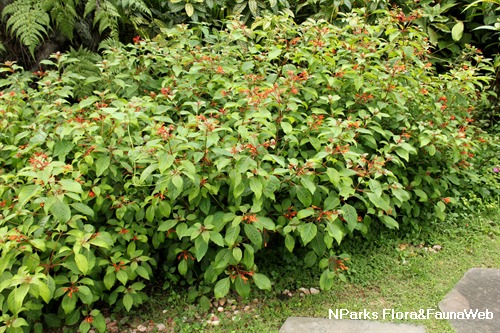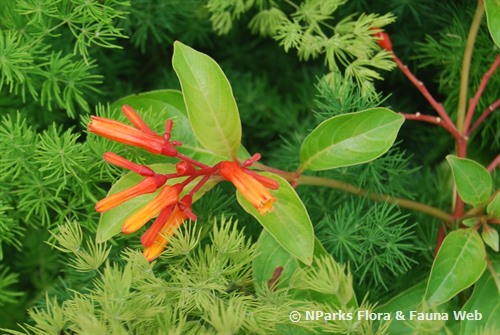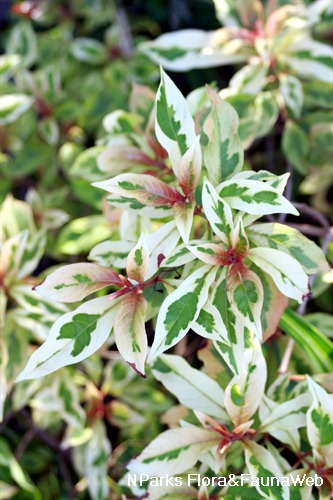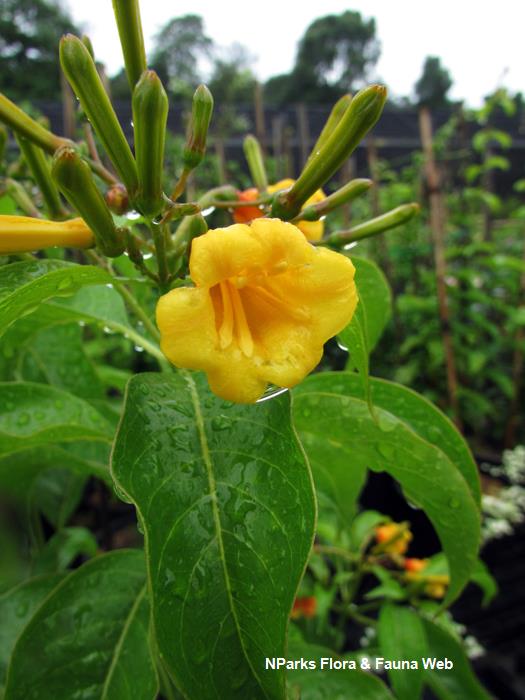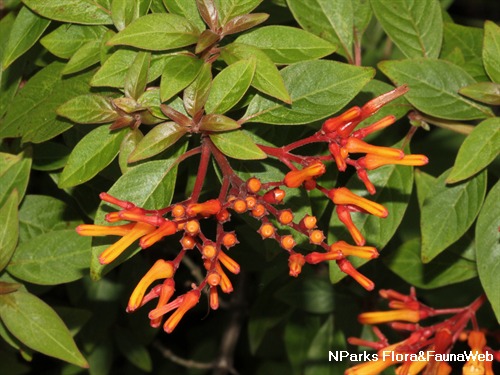
Back
Hamelia patens Jacq.
| Family Name: | Rubiaceae |
| Synonyms: | Hamelia erecta |
| Common Name: | Fire Bush, Scarlet Bush, Coloradillo, Hummingbird bush, Firecracker Bush, 长隔木, 希茉莉 |
Name
Classifications and Characteristics
| Plant Division | Angiosperms (Flowering Seed Plants) (Dicotyledon) |
|---|---|
| Plant Growth Form | Shrub |
| Lifespan (in Singapore) | Perennial |
| Mode of Nutrition | Autotrophic |
| Maximum Height | 0.5 m to 3 m |
Biogeography
| Native Distribution | West Indies, Mexico, Southern Florida, Central and South America |
|---|---|
| Native Habitat | Terrestrial |
| Preferred Climate Zone | Tropical |
| Local Conservation Status | Non-native |
Description and Ethnobotany
| Growth Form | Semi-woody shrub up to 3.7 m tall. |
|---|---|
| Foliage | Leaves are usually decussate, or arranged in whorls of 3, but sometimes up to 7. Young leaves are covered in red, woolly hairs which are lost as the leaves mature. Interpetiolar stipules triangular, falls at early stage (caducous). |
| Flowers | This plant is free-flowering. The orange-red flowers are arranged in cymes, clusters of flowers that occur at the end of forking floral stalks (terminal). Each flower has small and triangular lobes on a narrow tube (2.5 - 3.8 cm long) with swollen base. |
| Fruit | Black, oval to globose, berry-like fruits are fleshy (1.3 cm long). Fruits are yellowish to red at first, and mature to dark blue - black. |
| Cultivation | Although this shrub can tolerate shade, it produces much less flowers than under full sun. It is moderately drought tolerant, but grows best under regular watering. It cannot grow in saline soils. |
| Ethnobotanical Uses | Edible Plant Parts : Edible Fruits Medicinal: All plant parts have medicinal properties and used to treat wide range of ailments. Also possess anti-bacterial, anti-fungal and anti-inflammatory properties. Decoction from leaves, stems and flowers drunk to relieve menstrual cramps, or applied externally to treat skin problems like sores, rashes, burns and insects bites. Leaves have cooling effect and are chewed on a hot day as prevention againsty heat stroke in Venezuela. Also used to treat dysentery, fever, pain and headaches. |
Landscaping Features
| Desirable Plant Features | Ornamental Flowers |
|---|---|
| Landscape Uses | Flowerbed / Border, Hedge / Screening |
| Thematic Landscaping | Butterfly Garden |
| Usage Hazard - Cons | Invasive / Potentially Invasive |
Fauna, Pollination and Dispersal
| Fauna Pollination Dispersal Associated Fauna | Bird-Attracting (Flowers), Butterfly-Attracting (Flower Nectar) |
|---|---|
| Pollination Method(s) | Biotic (Fauna) (Insects (Bee), Insects (Butterfly, Moth), Vertebrates (Bird)) |
| Seed or Spore Dispersal | Biotic (Fauna) |
Plant Care and Propagation
| Light Preference | Semi-Shade, Full Sun |
|---|---|
| Water Preference | Little Water |
| Plant Growth Rate | Fast |
| Rootzone Tolerance | Well-Drained Soils, Saline Soils / Salt Spray, Drought Tolerant |
| Maintenance Requirements | Low |
| Diseases | Young plants are attacked by aphids. |
| Propagation Method | Seed, Stem Cutting |
| Planting Distance | 0 |
Foliar
| Foliage Retention | Evergreen |
|---|---|
| Mature Foliage Colour(s) | Green |
| Mature Foliage Texture(s) | Smooth |
| Foliar Modification | Stipule |
| Foliar Type | Simple / Unifoliate |
| Foliar Arrangement Along Stem | Whorled |
| Foliar Attachment to Stem | Petiolate |
| Foliar Shape(s) | Non-Palm Foliage (Oval, Elliptical) |
| Foliar Venation | Pinnate / Net |
| Foliar Margin | Entire |
| Foliar Apex - Tip | Acute |
| Typical Foliar Area | Mesophyll ( 45cm2 - 182.25 cm2 ) |
| Leaf Area Index (LAI) for Green Plot Ratio | 4.5 (Shrub & Groundcover - Dicot) |
Non - Foliar and Storage
| Stem Type & Modification | Woody |
|---|
Floral (Angiosperm)
| Flower & Plant Sexuality | Bisexual Flowers |
| Flower Colour(s) | Orange, Red |
|---|---|
| Flower Texture(s) | Smooth |
| Flower Grouping | Cluster / Inflorescence |
| Flower Location | Terminal |
| Individual Flower Shape | Tubular |
| Inflorescence Type | Cyme |
| Flowering Period | Free-Flowering |
| Flowering Opening Time | Night (dusk to dawn) |
| Flower Lifespan on Plant | [Remarks] |
| Flowering Habit | Polycarpic |
Fruit, Seed and Spore
| Mature Fruit Colour(s) | Black, Blue |
|---|---|
| Fruit Classification | Simple Fruit |
| Fruit Type | Fleshy Fruit , Berry |
| Seed Quantity Per Fruit | Numerous (>20) |
Image Repository
Others
| Master ID | 763 |
|---|---|
| Species ID | 2058 |
| Flora Disclaimer | The information in this website has been compiled from reliable sources, such as reference works on medicinal plants. It is not a substitute for medical advice or treatment and NParks does not purport to provide any medical advice. Readers should always consult his/her physician before using or consuming a plant for medicinal purposes. |

